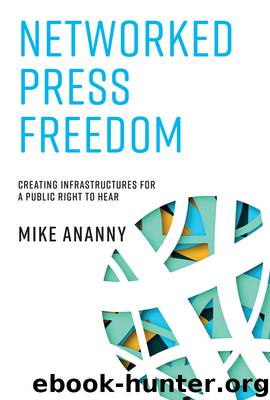Networked Press Freedom by Ananny Mike;

Author:Ananny, Mike;
Language: eng
Format: epub
Tags: The Press; freedom; democracy; free speech; truth; first amendment; publics; censorship; information; access; journalism; field; Pierre Bourdieu; networks; social media; social
Publisher: MIT Press
Labor
In his thoughtful study of digital news work, Matthew Powers (2012) observes that “Changes in the technologies of news production do not simply modify journalistic practices; they also introduce what might be considered technologically specific forms of work” (p. 24, emphasis in original). Such work, as we found in our study of mobile news app designers, is neither exclusively digital nor editorial but helps shape a “liminal press” (Ananny & Crawford, 2015) that both reifies and questions technological and journalistic traditions. If networked press freedom exists, in part, through envisioning and supporting different kinds of labor, what we see in the trade press are myriad initiatives, communities, and roles that attempt to balance separations and dependencies between journalists and technologists. What emerges is a complex story of how journalists both emulate and critique technological labor.
Some of these balances exist in entire news organizations centered on computational concepts and labor. Circa was founded on an “object-oriented” vision of news work that deconstructs the idea of the traditional news article, and it hired journalists who could think in “software development terms like forking and refactoring” in order to create a set of facts, stats, quotes, events or images that can be assembled and reassembled in the service of a news narrative.85 The company is one of several news organizations trying to create blended workforces that see news work as the creation and manipulation of structured content.86 This approach to news work is both relatively new (connected to software engineering notions of reusable and easily extensible code) and quite old (rooted in longstanding journalistic forms like the inverted pyramid, the standalone lede, and editing stories from the bottom). The trade press is filled with stories of people in these hybrid workforces reflecting on their identities as both journalists and coders,87 advocating for others to develop hybrid skills,88 and debating whether journalists should think of themselves as coders with software engineering skills or as general builders with the ability to tinker whenever their journalistic instincts suggest doing so.89 The New York Times even built an in-house computational tool to track its own staff’s Web browsing in an attempt to trace and summarize reporters’ intelligence work automatically and avoid duplication among workers.90
These debates occurred alongside the rise of professional organizations designed to blend editorial and technological mindsets and offer networking opportunities for this new labor market. Akin to what Fred Turner (2005) calls “network forums”—entities that simultaneously convene and represent diverse people who may otherwise share little—the trade press contains many mentions of new groups designed to facilitate hybrid labor. Hacks/Hackers was founded to “help journalists (hacks) and developers (hackers) learn from each other and collaborate on projects,”91 the Knight-Mozilla OpenNews group was designed to “strengthen the bonds between the worlds of journalism and software development”92 and to execute open source journalism projects,93 and the OpenNews initiative Source was designed to bring “wandering journonerds together under one roof” to share code and best practices.94
Newsrooms and platform companies alike trade in hybrid labor. When Joanna Geary
Download
This site does not store any files on its server. We only index and link to content provided by other sites. Please contact the content providers to delete copyright contents if any and email us, we'll remove relevant links or contents immediately.
The Secret History by Donna Tartt(18061)
The Social Justice Warrior Handbook by Lisa De Pasquale(11932)
Thirteen Reasons Why by Jay Asher(8401)
This Is How You Lose Her by Junot Diaz(6403)
Weapons of Math Destruction by Cathy O'Neil(5781)
Zero to One by Peter Thiel(5450)
Beartown by Fredrik Backman(5295)
The Myth of the Strong Leader by Archie Brown(5206)
The Fire Next Time by James Baldwin(4993)
How Democracies Die by Steven Levitsky & Daniel Ziblatt(4935)
Promise Me, Dad by Joe Biden(4893)
Stone's Rules by Roger Stone(4822)
100 Deadly Skills by Clint Emerson(4650)
Rise and Kill First by Ronen Bergman(4530)
A Higher Loyalty: Truth, Lies, and Leadership by James Comey(4523)
The David Icke Guide to the Global Conspiracy (and how to end it) by David Icke(4350)
Secrecy World by Jake Bernstein(4346)
The Farm by Tom Rob Smith(4296)
The Doomsday Machine by Daniel Ellsberg(4224)
